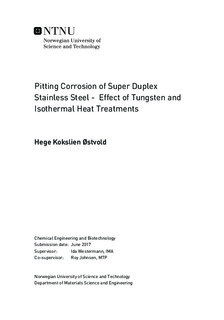| dc.description.abstract | Duplex stainless steels (DSS) and super duplex stainless steels (SDSS) can be described as austenitic-ferritic stainless steels with a chromium content of 22 and 25 %, respectively. Because of their good combination of superior corrosion resistance in chloride containing environments and high strength, together with a competitive cost, they are widely used in many industries. During production and fabrication of DSS and SDSS, they are exposed to heat treatments and welding. Since they also have a high content of alloying elements, they are prone to precipitation of deleterious intermetallic phases. When exposed to temperatures in the range of 800C to 900 C, which is the most interesting in this work, precipitation of sigma- and chi-phase, concurrently with secondary austenite are the most detrimental intermetallic phases. Due to these intermetallic phases, the duplex steels are prone to localized corrosion. This is because chromium and molybdenum are depleted from mainly ferrite, but also from the austenite phase.
To delay the precipitation of sigma-phase, it has been proposed to partially replace molybdenum with tungsten (W), which promotes the precipitation of phase. There are opposing opinions about the effect of tungsten addition in promoting chi-phase precipitation. Some claim the chi-phase to be more detrimental than the sigma-phase, while others look at the chi-phase as less deleterious, yet others have suggested that tungsten accelerated the precipitation of all deleterious phases, including sigma- and chi-phase. To examine how tungsten substitution affects the corrosion resistance of SDSS during isothermal heat treatments, two SDSS grades with 0 wt% and 2.1 wt% W was investigated. The results of this work were compared with previously obtained results by another student on a SDSS grade with 0.62 wt% W. Before electrochemical measurements, the test samples were solution annealed at 1110C and isothermally heat treated at 790C, 846C and 920C at different holding times. The electrochemical measurements consisted of an open circuit potential (OCP) measurement while exposed in 6 wt% ferric chloride solution with increasing temperature, to find the critical pitting temperature (CPT), and recording of anodic cyclic potentiodynamic polarization (CPP) curves. Prior to electrochemical measurements, another student performed metallographic examinations on the three mentioned SDSS grades. The influence of the microstructure was quantified by comparing the outcome of the electrochemical results with the detailed metallographic examination.
CPT was found to decrease with increasing isothermal heating time and, thus, increasing precipitation rate and amount of intermetallic phases. For almost all the holding times, CPT was found to increase in the order of SDSS containing 0.62 wt% W < 0 wt% W < 2.1 wt% W. A critical holding time was found to be between 2 and 4 minutes for SDSS containing 0 wt% W and between 4 and 10 minutes for SDSS containing 2.1 wt% W. The anodic CPP curves confirmed the results from the CPT measurements. The results indicated that relatively high tungsten additions promoted a better pitting corrosion resistance, whereas the opposite was observed at smaller additions. Surface characterizations after electrochemical measurements showed pitting corrosion to mainly initiate at the depleted areas around the intermetallic phases. | |

